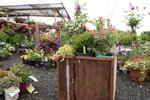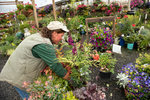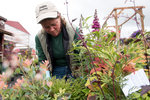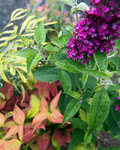



For Bill Moeller, a house is not a home without a garden.
So, when he moved to his home in Nylandia Park in Centralia about 2½ years ago, he knew he had his work cut out for him. His yard is only a few feet wider than the mobile home on any given side. But he was determined to make it work.
“You have to have a garden,” Moeller said.
Apparently, Moeller is not alone. More and more people, especially seniors, are turning to smaller homes in recent years. According to Windermere real estate, about 40 percent of Baby Boomers express a wish to downsize sometime in the next five years. And real estate company Trulia records that an estimated 37 percent of homeowners say they’d like to downsize their accommodations rather than upsize, while only 23 percent of homeowners feel the opposite. About 60 percent of homeowners living in homes larger than 2,000 square feet said they believed their next home would be a smaller one.
But living in a smaller square footage does not mean foregoing typical amenities such as a landscaped yard, it just means getting a little creative, said Moeller.
“You’ve got to decide what you want: lawn or garden,” Moeller said. “Most people choose lawn with a little garden but I went the other way.”
Moeller said he had to get permission from the park’s manager to remove sod to add more area for landscaping. He said the manager was hesitant at first because no resident had ever done a yard like what Moeller was suggesting. He drew up a plan for what he hoped to do to show him what was possible. The manager agreed to the change on a temporary basis and only in small portion to begin with.
“He liked it so much we did more,” Moeller said.
Containers are another tool for tiny yard landscaping that don’t require major land moving, said Bennie Ahrens, who has owned Bennie’s Gardens in Chehalis for 20 years. Ahrens suggests containers to those doing small scale gardening because they come in almost any size, shape, color and material possible so they can fit into any aesthetic. Ahrens said containers also serve a dual purpose in that they restrict a plant’s roots, therefore restricting its growth. There are so many more varieties of dwarf plants on the market today, Ahrens noted, that most gardeners in smaller spaces have a lot to choose from, and putting them in a container will ensure they stay smaller.
“If someone is going to make a bonsai they put it in a little tiny pot,” Ahrens explained. “It restricts the roots and restricts the growth.”
One of Moeller’s tricks for small spaces is shunning straight lines. Instead of a straight line delineating between lawn and flower beds, Moeller planned out an undulating pattern, which makes the flower beds deeper in some portions. This gives the visual effect that the yard is much deeper than it actually is.
“I think it makes the space look so much bigger. It’s a trompe l’oeil,” Moeller said, referring to a piece of visual art that is meant to trick the eye.
When it comes to gardening in smaller spaces, Moeller suggested choosing plants that are taller rather than wider. Taller plants add more visual appear as well as height and depth, he said. Some of Moeller’s favorites include: lupine; fox gloves; hollyhocks; and delphiniums.
Color can make a smaller area pop, Moeller noted. For instance, Moeller said he wanted to add a hedge row, and instead of using one of the typical evergreen species such as boxwood or arborvitae, he chose a dwarf rhododendron, which added an evergreen architectural background while also offering color.
Plants that play double duty, such as an evergreen that occasionally blooms, are a great choice for smaller spaces, Ahrens agreed. She suggested plants such as weigela, heuchera, nandina and even blueberry bushes are great because they either change colors with the season, flower, or both.
“If you don’t have much room you might as well have something that gives you a lot to look at,” Ahrens said.